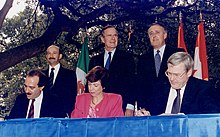User:Hns2000/sandbox
Along with many other Latin American countries in the early 1980s, Mexico experienced a debt crisis. In 1983 the Mexican government ruled by the PRI, the Institutional Revolutionary Party, accepted loans from the IMF. Among the conditions set by the IMF were requirements for Mexico to privatize state-run industries, devalue their currency, decrease trade barriers, and restrict governmental spending.[1] These policies were aimed at stabilizing Mexico’s economy in the short run. Later, Mexico tried to expand these policies to encourage growth and foreign direct investment (FDI).
The decision to accept the IMF’s neoliberal reforms split the PRI between those on the right who wanted to implement neoliberal policies and those the left who did not.[2] Carlos Salinas de Gotari, who took power in 1988, doubled down on neoliberal reforms. His policies opened up the financial sector by deregulating the banking system and privatizing commercial banks.[1][2] Though these policies did encourage a small amount of growth and FDI, the growth rate was far below what it had been under previous governments in Mexico and the increase in foreign investment was largely from existing investors.[2]

On January 1, 1994 the Zapatista Army of National Liberation, named for Emiliano Zapata, a leader in the Mexican revolution, launched an armed rebellion against the Mexican government in the Chiapas region.[3] Among their demands were rights for indigenous Mexicans as well as opposition to the North American Free Trade Agreement (NAFTA), which solidified a strategic alliance between state and business. NAFTA, a trade agreement between the United States, Canada, and Mexico, significantly aided in Mexico’s efforts to liberalize trade.
In 1994, the same year of the Zapatista rebellion and the enactment of NAFTA, Mexico faced a financial crisis. The crisis, also known as the “tequila crisis” began in December of 1994 with the devaluation of the peso.[2][4] When investors’ doubts led to negative speculation they fled with their capital. The central bank was forced to raise interest rates which in turn collapsed the banking system as borrowers could no longer pay back their loans.[4]
After Salinas, Ernesto Zedillo (1995-2000) maintained similar economic policies to his predecessor. Despite the crisis, Zedillo continued to enact neoliberal policies and signed new agreements with the World Bank and the IMF.[2] As a result of these policies and the 1994 recession, Mexico’s economy did gain stability. Neither the 2001 or 2008 recessions were caused by internal economic forces in Mexico. Trade increased dramatically, as well as FDI. However, as Mexico's business cycle synced with that of the United States, it was much more vulnerable to external economic pressures.[1](harvard and ll) FDI mainly benefitted the Northern and Central regions of Mexico while the Southern region was left poor. The crisis also left the banks mainly in the hands of foreigners.
The PRI’s 71 year rule ended when Vicente Fox of the PAN, the National Action Party, won the election in 2000. However, Fox and his successor Calderon did not significantly diverge from the economic policies of the PRI governments. They continued to privatize the financial system and encourage foreign investment.[2] Again, these policies were unsuccessful in promoting growth in the Mexican economy. Despite significant opposition, Enrique Peña Nieto, president from 2012 - 2018, pushed through legislation that would privatize the oil and electricity industries. These reforms marked the conclusion to neoliberal goals that had been envisioned in the 1980s.[2]
Andres Manuel Lopez Obrador (AMLO), elected in 2018, ran on an anti-neoliberal platform. His policies, specifically related to economics and the coronavirus, have been criticized heavily. AMLO argued that "It is foolish to be thinking more of the same! We've already broken the mold of neoliberalism. We can't put new wine in old bottles!"[5] However, AMLO's plan to boost the economy is very minimalist, and is much less comprehensive than many other Latin American countries'.
- ^ a b c Musacchio, Aldo (May 2012). "Mexico's financial crisis of 1994-1995". Harvard Business School Working Paper. 12–101 – via DASH.
- ^ a b c d e f g Laurell, Asa Cristina (2015). "Three Decades of Neoliberalism in Mexico: The Destruction of Society". International Journal of Health Services. 45 (2): 246–264 – via SAGE.
- ^ Godelmann, Iker Reyes (July 30, 2014). "The Zapatista Movement: The Fight for Indigenous Rights in Mexico". Australian Institute for International Affairs.
{{cite news}}: CS1 maint: url-status (link) - ^ a b Sachs, Jeffrey (November 1996). "The Mexican peso crisis: Sudden death or death foretold?". Journal of International Economics. Volume 41, Issues 3–4: 265–283 – via Science Direct.
{{cite journal}}:|volume=has extra text (help) - ^ Translated by ContentEngine, L. L. C. "AMLO: 'Non-Orthodox' Economic Plan Goes, no Bailouts Or Debt." CE Noticias Financieras, English ed. ed., Apr 05 2020, ProQuest. Web. 30 Sep. 2020 .

